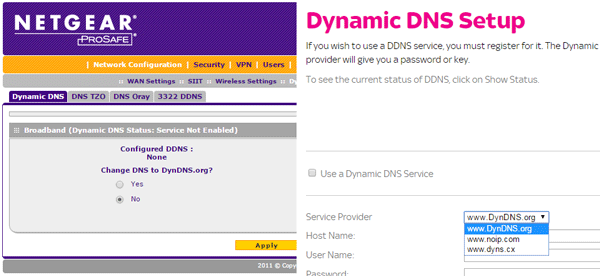Dynamic DNS
The website is running and traffic is routed correctly from the Internet,
however at this stage it can only be accessed from the outside world by typing
an IP address into a browser. This can suffice if the sites targeted user base
is only yourself or a small group of users, but the biggest issue hosting on a
home internet connection is that the IP address will change often due to having
a dynamic IP assigned. Internet providers use dynamic IPs for a number of
reasons with deterring servers one of them. To find out if you have a dynamic
IP, visit
http://www.whatsmyip.org on different days to see if the IP changes.
Luckily there is a way to get around changing IP addresses by using a Dynamic
DNS (DDNS) service online.
DDNS providers offer a service that gives users a choice of memorable sub
domain, that translates to an IP address that is kept up to date via software on
the server or configuring a router.
Signup
There are a few companies that offer DDNS services ranging from free to
subscription based, when signing up make sure that an update client is available
to download from the site and also check for any updating limits with the
service, while a Dynamic IP may only change once a day it needs to be checked
frequently to ensure a change in IP is updated quickly.
I recommend DynamicDNS
as a free service due to its simplicity in signing up and running.
For a paid option I use DynDNS
that until recently had a free service, but the subcription based option allows
to update different locations from a single account, and Dyn is supported on a
wide selection of routers.
Software
All DDNS services allow IP updating either manually through it's website or by
using software running on the local network. When running a home server its best
to install an update client on the server itself as the updating will be in sync
with the running of the server.
Simply download the client from the service's site, install and login with your
account.
If the option is available then choose to install the client as a service, this
ensures the client is running and updating as long as the server is powered on
with no need to logon as a user to update.
Router
A lot of routers have the ability to update a DDNS account itself, therefore
doing without a client on the server. The service's supported depends entirely
on the router in use but DynDNS and NoIp are available on most models.

Look around the router setup menu for an option for DDNS or Dynamic IP
configuration.